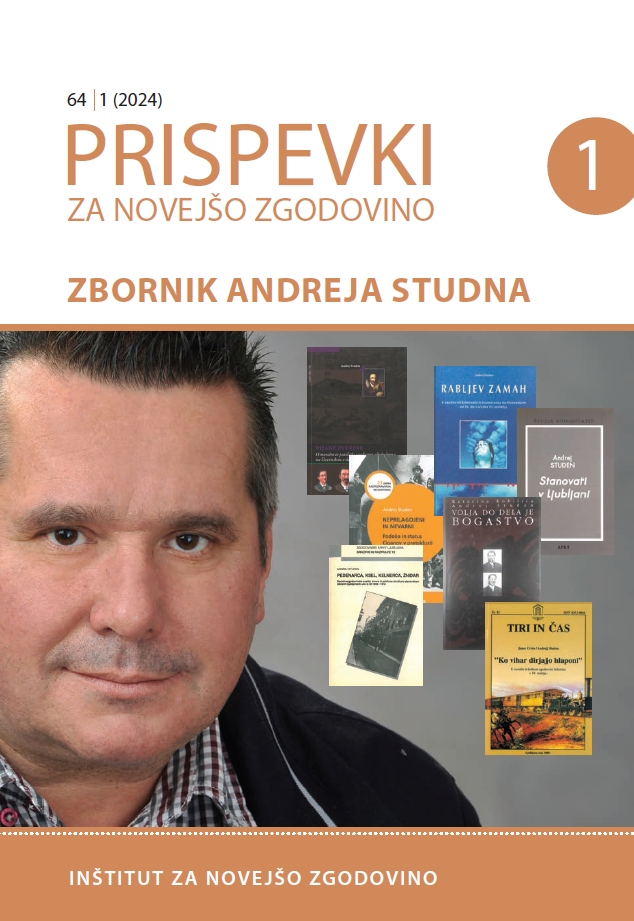A Roof over Your Head Roofing of Rural Dwellings and Outbuildings in the Karst (Mid-18th Century)
DOI:
https://doi.org/10.51663/pnz.64.1.06Keywords:
rural architecture, standard of living, the Slovenian LittoralAbstract
The contribution addresses the long-standing question of the roof covering materials for rural buildings in the Karst region and the chronology of the prevalence and replacement of straw, slates, and bent tiles from the 16th to the 19th century. The article first outlines the interpretative and chronological uncertainty of the existing literature. Next, it presents the early modern written testimonies and iconography of towns and villages in the Slovenian Littoral, demonstrating their partial discrepancy with the existing interpretations and the ambiguity of the relevant depictions. The central part of the article analyses the original archival data from real estate transactions between peasants, which contain information on the type and value of roof coverings on 27 residential and 13 outbuildings in 15 localities in the Karst region in the middle of the 18th century. Most of these houses were covered with slates, while most outbuildings were thatched, except for the Goriška-Vipava area, where bent tiles prevailed. These results provide a reliable timeline foundation for further research.
References
Ciglič, Zvona. Kamniti svet. Koper: Pokrajinski muzej, 1993.
Darovec, Darko (ur.). Stari krajepisi Istre. Koper: Zgodovinsko društvo za južno Primorsko, 1999.
Fister, Peter. Arhitektura na Krasu. V: Andrej Kranjc (ur.). Kras: pokrajina, življenje, ljudje. 251–60. Ljubljana: Založba ZRC, ZRC SAZU, 1999.
Kernel, Davor. Kamnolomstvo in kamnoseštvo na Krasu. Nova Gorica: Goriški muzej, 2003.
Križnar, Naško. Etnografska podoba Krasa. V: Andrej Kranjc (ur.). Kras: pokrajina, življenje, ljudje, 217–49. Ljubljana: Založba ZRC, ZRC SAZU, 1999.
Križnar, Naško. Odlomki iz materialne kulture na Krasu. V: Zorko Harej (idr.). Kamnita hiša: tipi in oblike. Trento: Luigi Reverdito Editore, 1984.
Lah, Ljubo. Naselbinska in stavbna dediščina Krasa. V: Andrej Kranjc (ur.). Kras: pokrajina, življenje, ljudje, 260–71. Ljubljana: Založba ZRC, ZRC SAZU, 1999.
Ledinek Lozej, Špela. Raziskave stavbarstva in bivalne culture Vipavske doline. Pregled poglavitnih virov in literature pred drugo svetovno vojno. Traditiones 35, št. 1 (2006). 219–45.
Pagnini, Maria Paola. La casa rurale del Carso Triestino. Atti del Museo di Storia Naturale – Trieste XXV, f. 5 (1966), n. 5, 107–37.
Panjek, Aleksander. Človek, zemlja, kamen, in burja. Zgodovina kulturne krajine Krasa. Koper: Založba Annales, 2006.
Panjek, Aleksander. Gospostvo in skupnost Rihemberk v dinamičnem 16. stoletju. V: Miha Preinfalk (ur.). Grad Rihemberk. Ljubljana, Založba ZRC [v tisku].
Panjek, Aleksander. Kulturna krajina in okolje Krasa. O rabi naravnih virov v novem veku. Koper: Založba Univerze na Primorskem, 2015.
Panjek, Aleksander. O mejnosti Goriške grofije v baroku – gospodarski in družbeni pogled. V: Ferdinand Šerbelj (ur.). Barok na Goriškem / Il Barocco nel Goriziano, 167–71. Nova Gorica: Goriški muzej, 2006.
Panjek, Aleksander. Staro jedro Devina v zgodnjem novem veku. Začarana risba iz arhiva. Kronika 63, št. 3 (2015): 475–93.
Pillon, Lucia (ur.). Gorizia, un viaggio nel tempo. L'immagine del Castello dal nostro secolo alle origini. Gorizia: Edizioni della Laguna, 1995.
Premrl, Božidar. Kamnita strešna kritina stavb na Primorskem – II Aplikativna raziskava. Ljubljana: Zavod za varstvo kulturne dediščine Slovenije Restavratorski center, 2005.
Premrl, Božidar. Nesmrtni kamen in njegovi mojstri v gornji Vipavski dolini in okolici. Ljubljana: Založba ZRC, 2022.
Renčelj, Stanislav in Ljubo Lah. Kraška hiša in arhitektura Krasa med očarljivostjo in vsakdanom. Koper: Libris, 2008.
Renčelj, Stanislav. Kras: kamen in življenje. Koper: Libris, 20061.
Rupel, Mirko in Branko Reisp (ur.). Valvasorjevo berilo. Ljubljana: Mladinska knjiga, 1969.
Schöggl-Ernst, Elisabeth, Markus Leideck in Marko Medved (ur.). Johannes Clobucciarich – Leben und Werk. Rijeka in Graz: Državni arhiv u Rijeci in Steiermärkisches Landesarchiv, 2022.
Sedej, Ivan. Kmečka arhitektura na Krasu. V: Kraška hiša: vodnik po razstavi, 3–10. Ljubljana: Slovenski etnografski muzej, 1969.
Sedej, Ivan. Sto najlepših kmečkih hiš na Slovenskem. Ljubljana: Prešernova družba, 1989.
Slokar, Ivan. Zgodovina ljubljanskih opekarn od leta 1732 do 1860. Kronika 8, št. 1 (1960): 40–50.
Tommasini, Giacomo Filippo. De' Commentari storici-geografici della Provincia dell'Istria libri otto con appendice. Di Monsig. Giacomo Filippo Tommasini Vescovo di Cittanuova. L'Archeografo Triestino. Raccolta di opuscoli e notizie per Trieste e per l'Istria, vol. IV, 1837: 1–563.
Valvasor, Janez Vajkard. Topografija Kranjske 1678–1679 (Skicna knjiga). Faksimiliran natis originala iz Metropolitanske knjižnice v Zagrebu, ur. Jože Gostiša in Branko Reisp. Ljubljana: Mladinska knjiga, 2001.
Valvasor, Janez Vajkard. Topographia ducatus Carnoiolae Modernae. Bogenšperk na Kranjskem 1679. Faksimirana izdaja, ur. Branko Reisp. Ljubljana in München: Cankarjeva založba – Rudolf Trofenik, 1970.
Valvasor, Johann Weikard. Die Ehre dess Hertzogthums Crain. Nürnberg: Wolfgang Moritz Endter, 1689.
Downloads
Published
Issue
Section
License
Copyright (c) 2024 Aleksander Panjek

This work is licensed under a Creative Commons Attribution 4.0 International License.
Authors who publish with this journal agree to the following terms:
- Authors retain copyright and grant the journal right of first publication with the work simultaneously licensed under a Creative Commons Attribution License that allows others to share the work with an acknowledgement of the work's authorship and initial publication in this journal.
- Authors are able to enter into separate, additional contractual arrangements for the non-exclusive distribution of the journal's published version of the work (e.g., post it to an institutional repository or publish it in a book), with an acknowledgement of its initial publication in this journal.
- Authors are permitted and encouraged to post their work online (e.g., in institutional repositories or on their website) prior to and during the submission process, as it can lead to productive exchanges, as well as earlier and greater citation of published work (See The Effect of Open Access).


